Spiders are fascinating animals. They are highly adaptable and are found in all types of habitats and around the globe. Antartica is the only continent without spiders. Some species have developed fascinating capabilities and techniques while others are simply fascinating by their appearance. In this article, we have compiled an overview of the most fascinating spider facts for you.
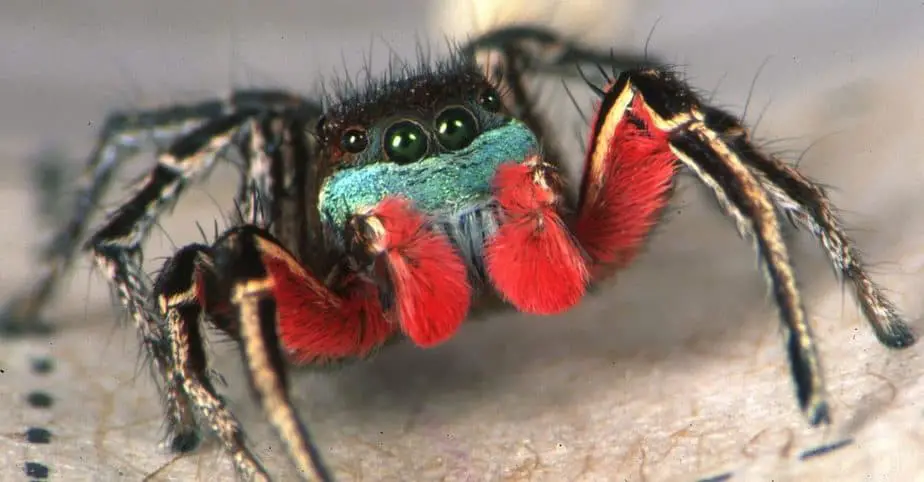
Table of Contents
How many spiders are there in the world and in the United States?
As of 2021, are over 46,000 species of spiders in the world. Around 3,000 species are recorded in the United States. Many species are still undiscovered and every year, numerous new species are discovered and described.
Almost all of the 40,000 spider species in the world are venomous, only two families of small spiders lack the ability to create venom. However, only about 25 species in the world care considered “medically significant” spiders and could cause medical issues for humans or larger pets. In the United States, only the recluse spiders (Loxosceles) and widow spiders (Latrodectus) are considered medically significant.
Spiders are not Insects – They are Arachnids
Spiders are often falsely referred to as insects. That is wrong. Spiders are arachnids, along with scorpions, mites, harvesters and ticks. All arachnids have eight legs and two main body parts (a cephalothorax and an abdomen).
In contrast, insects have six legs and three main body parts (a head, a thorax and an abdomen). Similar to insects, spiders have an open circulatory system (not closed veins like humans or mammals) and a breathing tube, called trachea, that supplies the body with oxygen.
Facts about the diet and hunting behaviors of spiders
Spiders feed almost exclusively on insects – from small to large. Combined, all spiders in the world consume around 800 million tons of prey per year. 90% of which are insects. In comparison, all whales on earth consume only around 450 million tons of biomass per year.
Therefore, spiders play an important role in keeping the balance in our natural ecosystem. The spiders in your backyard are removing hundreds of annoying mosquitoes and other crawly creatures. In fact, a single spider eats around 2,000 insects each year. We should see spiders as a blessing, not a curse.
Spiders use their venom mostly to immobilize their prey. As soon as the prey is incapacitated, the spider will spit up digestive juices onto it and wrap it up in silk. The juices digest the prey inside the silk bag which the spider will then suck out.
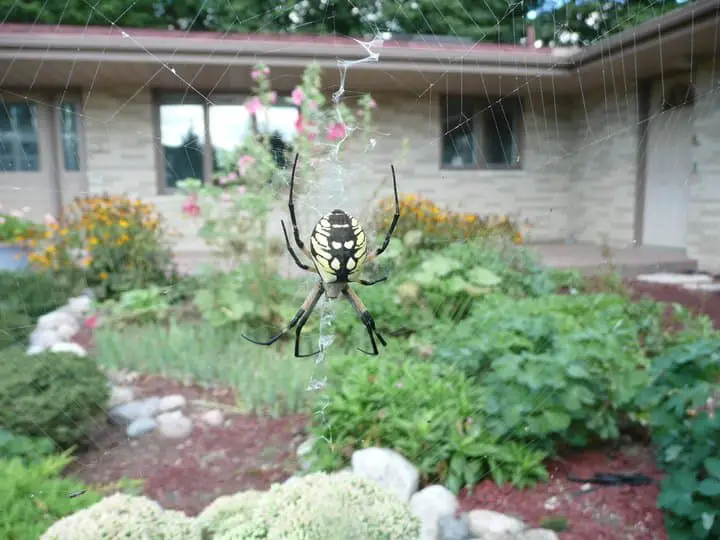
World’s only (almost) vegetarian spider
In the 21st century, the world has changed. Humans need to rethink their eating habits and work towards a more sustainable future for our planet. Fittingly, in 2009, scientists discovered a spider species in Central America that is mostly herbivorous.
Bagheera kiplingi is the world’s first and only (almost) vegetarian spider species known to humanity. The small iredescent green or yellow jumping spider feeds almost exclusively on protein-rich parts of mimosa trees.
Next to its vegetarian preferences, the spiders also snack on ant larvae and, if the hunger is getting unbearable, they even feast on their fellow spiders.
Snake- and bird-eating spiders
Large spiders are occasionally seen hunting and eating snakes, birds, lizards or small rodents. Here is a video of a goliath birdeater spider hunting a lizard:
Also large orb-weaving spiders that are found in the United States occasionally snack on something other than flies and moths. Here is a news article about a black and yellow garden spider (Argiope aurantia) that caught and ate a decent-sized bat in Texas. Well, as the say: everything is bigger in Texas. Nephila orb weavers also catch the occasional small bird in their large webs.
Special hunting techniques
The net casting spider (Deinopis) has developed a very special hunting technique: It prepares a folded web which it holds with its four front legs. It then lurks in its web, waiting for a prey animal to come within reach, and then quickly slips the prepared web over it. Check out this video how the technique works:
The spitting spider, Scytodes thoracica, projects liquid venomous silk from its mouth at its prey. Upon contact with air, the liquid silk solidifies and catches and together with the venom in the silk, immobilizes the prey.
Around 300 species of spiders mimic the behavior, appearance or even scents of ants. They do this to deceive ants and to get close to them unnoticed and then attack them from behind.
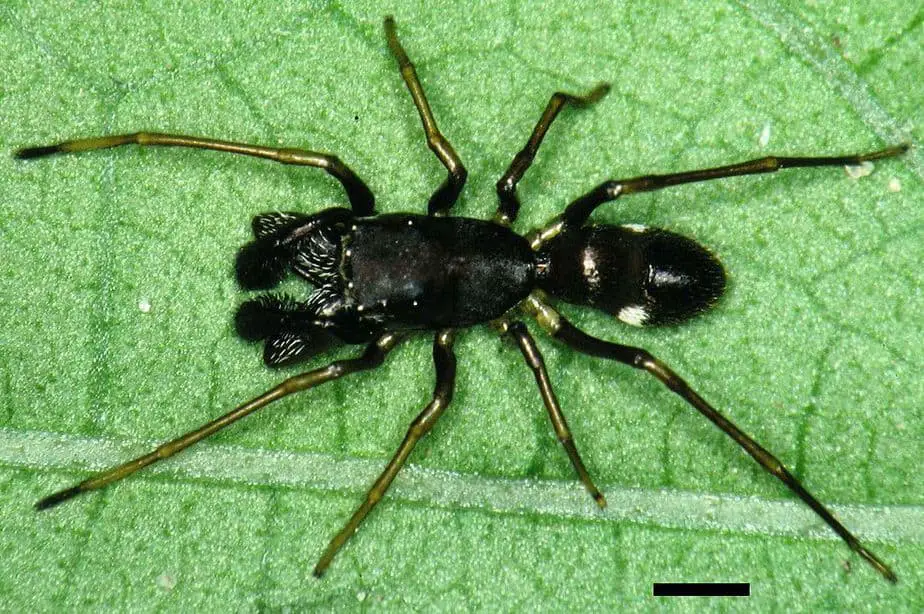
Largest and smallest spider facts
Spiders come in all sizes. The dreaded massive ones that haunt us in our dreams or the itsy-bitsy tiny ones we don’t see coming.
The largest spider in the world
World’s largest spider by body size and body mass is the goliath birdeater (Theraphosa blondi), a tarantula found in the rainforests of Northern South America. This massive spider can reach a legspan of up to 1 foot (30 cm) and a body length of over 5 inches (13 cm). Their total body weight can reach 6.2 oz (175 g). We have seen one of these species munching down on a lizard in the video above.
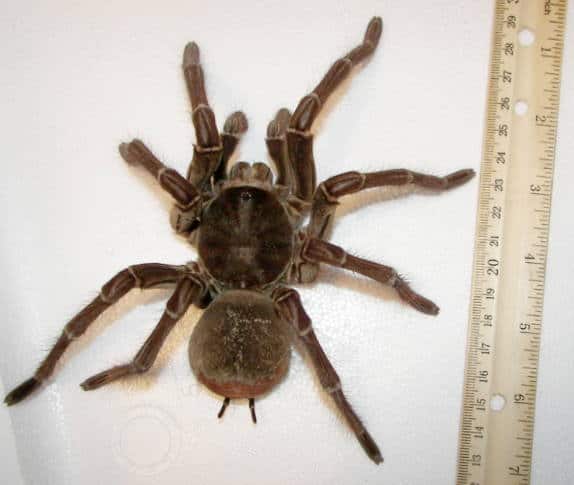
Despite their size, birdeaters can’t really cause any harm to humans or large pets as their venom isn’t very strong. A bite can have similar symptoms as a bee sting. But honestly, we would prefer not to be hunted by this humongous spider.
The largest spider species in the world by legspan is the giant huntsman spider (Heteropoda maxima), discovered in 2001 in Laos, Southeast Asia. This massive spider can reach a legspan of over 1 foot (30 cm), making the largest discovered specimen slightly larger than the goliath birdeater. However, this spider is mostly legs and it’s body length and body mass is “only” a fraction of the birdeater, reaching up to 1.8 inches (4.6 cm).
The largest recorded individual spider was giant green huntsman spider Charlotte, found in Australia in 2015 measuring almost 16 inches (40 cm) legspan.
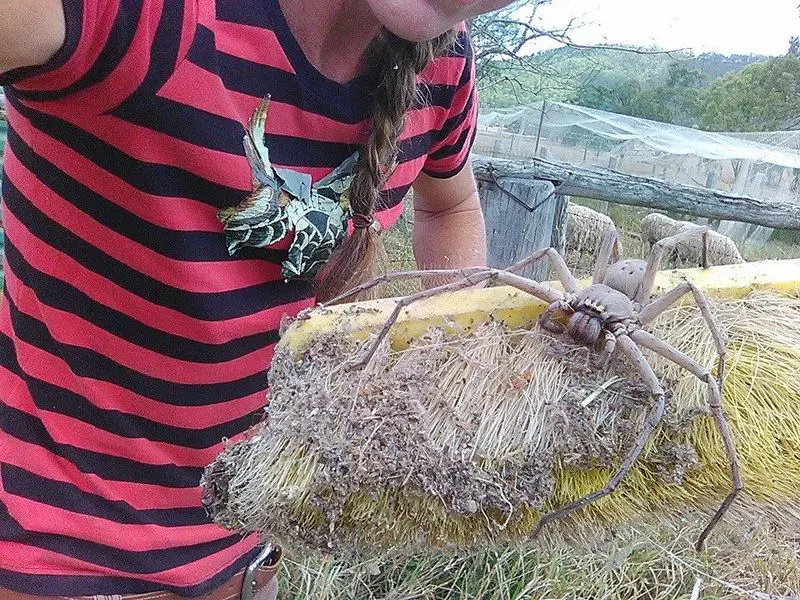
The largest spider in the United States is the Texas brown tarantula (Aphonopelma hentzi) that can reach a legspan of over 4 inches (10 cm) and weigh more than 3 oz (80 g). The second largest spider in the United States is the Carolina Wolf Spider (Hogna carolinensis) reaching a legspan of up to four inches (10 cm).
World’s smallest spider
With a maximum body size of 0.015 inches (0.37 mm), the Patu digua spider, native to Colombia, is the smallest known spider in the world.
Size Difference between male and female
In most species, the female spider is larger than the male.
The females of Tidarren sisyphoides, a species of tangle web spider, are a hundred times larger than the males.
How many eyes do spiders have?
Most, almost all, spiders have eight eyes. The eye arrangement differs from each genus to the other and can be a great tool to tell similar-looking spiders apart.
There are also spiders that have only six eyes, very few have four eyes or even two. The infamous recluse spiders of the family Sicariidae, for instance have only six eyes.
There is even one known spider species in the world to have no eyes at all: Sinopoda scurion is a huntsman spider discovered in a cave in Laos, Southeast Asia in 2012 that has no eyes at all. Since it lives in total darkness, it has no need for them.
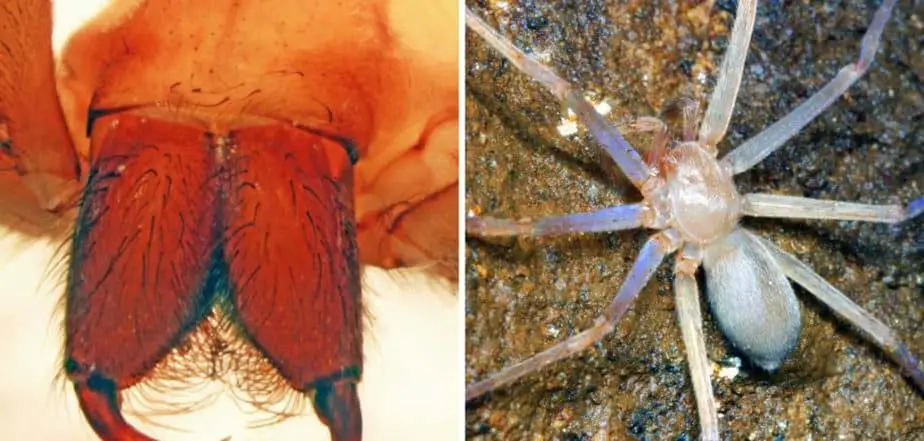
Spiders have blue blood
Spiders and snails have blue blood. Since the circulatory system of spiders is different from humans and mammals, it is scientifically called haemolyph, not blood. Spiders have an open circulatory system (not veins or arteries) and the “blood” is pumped through the bodies.
Spider Silk Facts
All spiders have the ability to produce silk, a strong protein fibre.
Spider silk comes out of the silk glands in liquid form and hardens upon the contact with air.
Spiders use the silk for various uses. Here are some of the main uses of spider silk.
- Capturing and immobilizing prey
Many spiders spin webs to catch prey. The silk used in webs is usually sticky so anything that touches the web is stuck. The spider can feel the vibrations generated by the potential prey and immediately rushes towards it to deal an immobilizing bite. After that, it usually uses more silk to wrap up the prey. Different species of spiders create different styles of webs: orb webs, tangle webs, dome webs, funnel webs, sheet webs and many more.
- Stabilization
Jumping spiders have the ability to make huge leaps, sometimes into the unknown. When performing especially daring jumps, jumping spiders often spin a “safety line” while jumping. If their jump fails, they can fall into the safety line and climb back to the starting point.
- As a meal
Yes, some spiders even eat spider silk. The commonly found orb weavers mostly rebuild their webs daily and eat it at the end of the night. They do this in order to reduce the energy consumption that is required to produce the protein fibres.
Other spiders, like the parasitic dewdrop spider, feed on the web of other spiders.
- To fly
Yes, you heard right. Some juvenile spiders spin a long, single thread of silk and use the wind to “fly” through the air. Some specimens can fly several kilometers with this technique that is used by spiders to explore new habitats. This process is called ballooning.
- Reproduction
Some male spiders create webs that they cover with their sperms. They will then use their pedipalps to inseminate the female. Other spiders leave a single strand of silk covered with pheromones to signal male spiders.
- Silk as a diving bell
The diving bell spider (Argyroneta aquatic) spins a “diving bell” out of silk that holds oxygen and then submerges into the water with its airtight bubble. The spider lives almost exclusively under water and only emerges to refill its oxygen tank.
Seven Types of Spider Silk
Depending on the use, the spider produces different types of silk. These types differ in the chemical composition and strength of the fiber. Different types of silk are produced by different silk glands. However, not all spiders possess the ability to create all seven types of silk:
| Silk Gland | Use and Strength of the Silk |
| Ampullate (major) – Dragline Silk | Very strong silk used for the stabilization of webs. Used by jumping spiders as a lifeline and for ballooning by juvenile spiders. |
| Ampullate (minor) | Used for temporary elements when constructing a web. |
| Flagelliform – Capture-spiral silk | The inner strands of the spider web that serve to catch prey |
| Tubuliform – Egg cocoon silk | Used to wrap eggs into egg sacs |
| Aciniform | To secure and wrap prey. Used by male’s in sperm webs. |
| Aggregate | A type of sticky glue silk |
| Piriform | Used to connect several strands of silk. |
Fishermen from New Guinea use the web of the silk spider (Nephila) to catch fish because it is extremely tough.
The silk of the Darwin’s bark spider, Caerostris darwini, is the toughest biomaterial in the world – more than ten times stronger than a comparable strand of Kevlar and twice as strong as any other known spider silk. This spider also creates the largest webs in the world – spanning up to (30 feet) 10 meters.
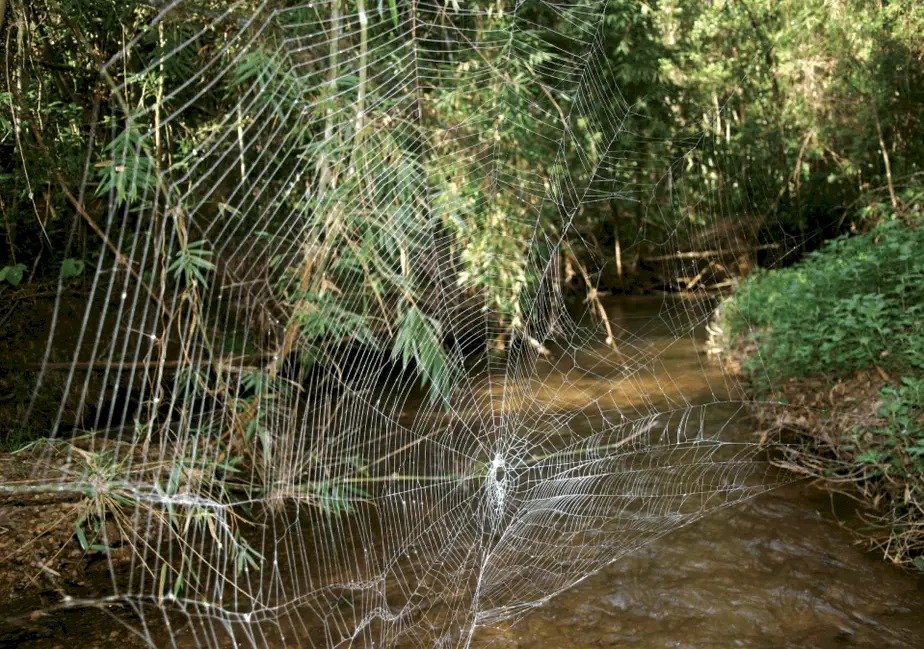
How long do spiders live?
Most spiders live for about a year, like the common orb weaver spiders. The adult female lays its eggs in autumn before passing away. The spiderlings either hatch and overwinter or stay in their egg sac until the temperatures rise. Between spring and autumn, they grow and reach adulthood before laying their eggs and passing away themselves.
The oldest spider in the world was “Number 16”, a female Australian trapdoor spider. She died at the age of 46 years. Several tarantula species live for over 20 years.
Spooky Spider Facts
The spider species Amaurobius ferox is considered a matiphagous spider. This means that the spiderlings eat their own mother after hatching from her eggs.
Do humans eat spiders in their sleep?
It is a hoax that a person swallows an average of four (or any number of) spiders in his/her lifetime while sleeping. It is very unlikely that a spider will ever enter the mouth of a sleeping person.
Spider Venom Facts
Spiders are venomous, not poisonous. Poisonous refers to things that are ingested, like a mushroom. Animals that administer venom through a bite are considered venomous.
More people die each year from champagne bottle corks than from the bite of a venomous spider.
Around 5 people die each year from a spider bite in the United States. At the current population level, that is a chance of around 1:70 million.
The chance to die from a bee sting or a wasp sting is about 10 times as high.
The venom of the black widow spider has a different effect on different mammals. Humans, horses and cats are highly susceptible to the venom. A bite can result in serious medical issues. Dogs, sheep and rabbits show little to no effects from a bite.
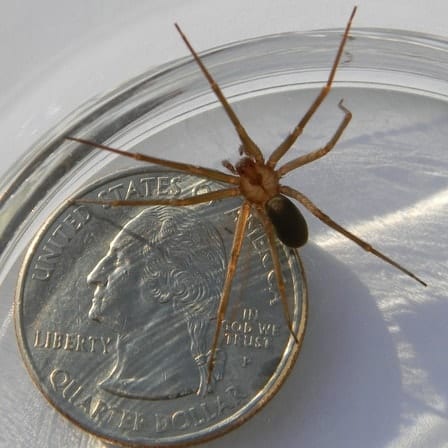
Most colorful and fascinating spiders
The male peacock spider, Maratus volans, is considered the most colorful spider in the world. It performs a colorful and fascinating dance for potential mates, similar to the behavior of some birds-of-paradise.
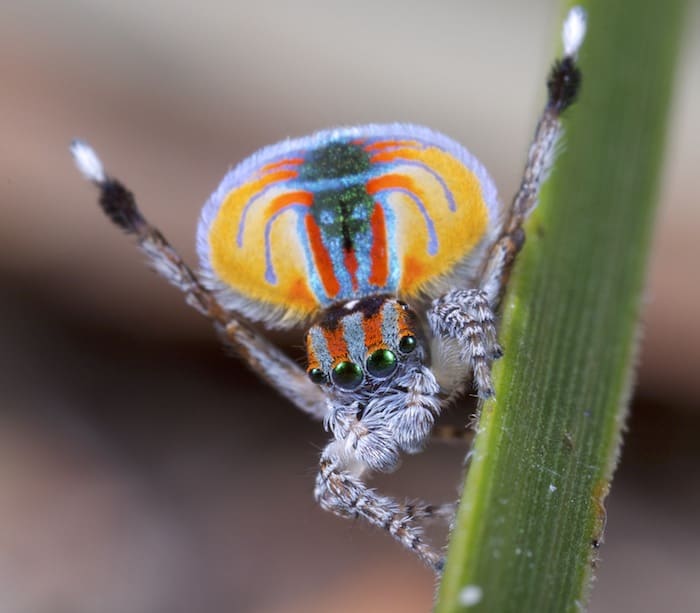
Tarantulas are popular pets and a number of colorful breeds can be found throughout the world. Our favorite colorful tarantula species is Dolichothele diamantinensis, the Brazilian diamond tarantula:
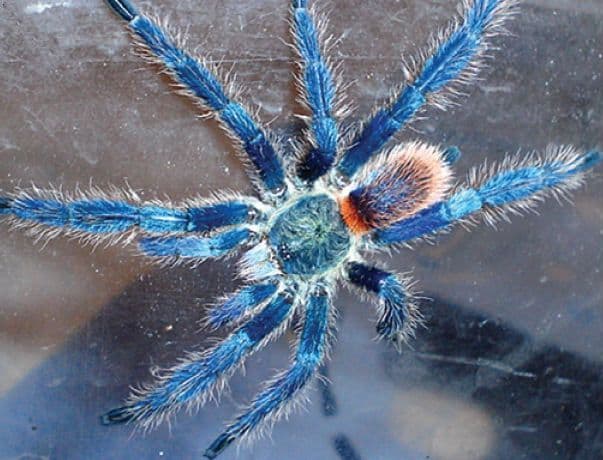
The pelican spider, that was once thought to be extinct is a tiny spider shaped like a pelican that preys on its own kind:

I’ve never seen a spider so comically red before! It’s not much bigger than the diameter of the tip of a pen cap. Seems like it could have some lighter red bands on the body. Lynchburg, Virginia.
Hello Melissa,
Based on the picture, I would say that this is a velvet mite (not a true spider):
https://bugguide.net/node/view/360863/bgpage
Best regards
I live in Iowa and have seen several black spiders with large bodies, they crawl really fast and today one of them jumped to get away from me.
I didn’t see it long enough to get a picture as it moved so quickly.
I am concerned if it is poisonous to me but can’t describe it’s markings since it moved so fast away from me.
I think they like my environment with all of the papers I’ve failed to throw out and they pile up!
( yes, I’m an unhappy hoarder!). Do you know who I can talk to that helps with my problem?
I would welcome their help! Ha ha.
Next time I see one of those spiders, I will try to get a picture if I can. Its body is maybe 1/4” in size and its legs are very thick. It appears it likes to hide amongst papers and spin webs at night? I found several webs, maybe most in corners, in my bedroom of my manufactured home.
Of course it’s so hot and humid right now in July with temps in upper 90s and humidity in upper 70s, so I’ve been staying inside most of the time as well. I’m disabled with MS but trying to clean up my environment as best I can, but my energy level is very low most of the time!
Thank you for your time. I’m sorry I wasn’t very much help in describing this spider, but I doubt if it is even possible for it to be venomous?
Julie, NW Iowa.
Hello Julie, thanks for getting in touch. It’s highly unlikely that what you saw was a venomous spider. The only medically significant spider found in Iowa is the brown recluse and it occurs only in the Southern part of the state. And that spider is brown.
What you describe sounds very much like a jumping spider – which are not medically significant spiders.I think the bold jumper could be a good fit for what you described: https://usaspiders.com/phidippus-audax-daring-jumping-spider/
But since jumping spiders don’t spin webs, you might also have some other spiders that are a little more secretive that create the webs in the corners. These are generally harmless spiders – the range of the northern black widow does not extend as far west was Iowa.
I hope that helps.
Best
Michael
Hi. I think the attached photos are of a western spotted orb weaver. But would like confirmation. I’m in Elgin AZ. We’ve had a wetter than average monsoon and I’ve got a ton of these guys on my flowers. Most are fairly small and more orange & yellow. But there’s a big one on a porch window with blue markings (the pictures I’m sending). Great website.